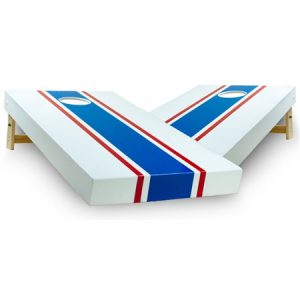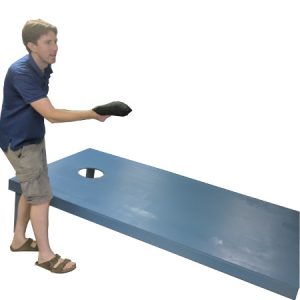
Until recently, I didn’t know the true name for that “Bean Bag Toss Game.” You know, the one where you throw bean bags at a board with holes in it to score points for your team? Well, with outdoor party season upon us and old fashioned backyard games making a big comeback, we should all know the name of that game: It’s not corn toss, bean toss, soft horseshoes, Indiana horseshoes, or any kind of horseshoes…it’s Cornhole!
Cornhole: What Is It?
Cornhole or Corn Toss is a lot like horseshoes except instead of the metal stakes and horseshoes, Cornhole uses wooden boxes with holes in them called cornhole platforms and corn bags. Participants take turns tossing their corn bags at the cornhole platform or cornhole board until one of them reaches the score of 21 points. A corn bag which lands in the hole scores 3 points, while one which lands on the platform scores 1 point.
Cornhole: How Is it Played?
The game is generally played tournament style with an individual or team being named the champion at the end of the tournament.
Before playing, however, you need to make sure to set up your cornhole game and understand how the game is played. If you want to really get technical, the ACO (American Cornhole Organization) has a thorough set of Cornhole Official Rules and equipment specifications which can be found on their website here. Since most of us aren’t here to learn how to become professional Cornhole players, however, the guidelines below can help walk you through how to set up and play a fun and exciting game.
Setting Up a Cornhole Game

Equipment:
To play cornhole, you will need 2 cornhole boards and 8 beanbags (4 each of 2 colors – usually 4 red and 4 blue).
Regulation cornhole boards are typically made of plywood measuring 4′ long by 2′ wide and weighing in at about 25lbs. Each board has a hole in it 6″ diameter and 9″ from the top of the board, centered from each side edge. The playing surface has a smooth finish so as not to distort the play – it may be painted with a high gloss paint or varnish so bags can slide when thrown.
Regulation bags are about 6″ by 6″ and weigh about 1 pound. They are made from durable fabric such as canvas or suede and are sewn together with double stitching to make them strong enough to withstand being thrown and landing on a hard surface over and over again.
Court:
A regulation cornhole court is 8 feet wide and 40 feet long. The court should also have 12′ vertical clearance.
The 2 cornhole boards are positioned at opposite ends of the court 27′ from front edge to front edge of the boards. The front of each board is 3″ to 4″ from the ground to the top of the playing surface and the back of the board is about 12″ from the ground to the top of the playing surface.
There are 4 pitchers boxes and they are set up on both the left and right sides of each of the boards. These boxes are 4′ x 3′ each.
The front edge of the boards (and pitchers boxes) mark the foul lines.
Cornhole Rules:
- Players must pitch all 4 cornhole bags from their designated cornhole pitchers box.
- Players must toss the bags underhand.
- One foot or appendage must be completely inside the pitchers box when the bag is released.
- Players must release the bag before any part of the player’s body touches the ground on or beyond the foul line.
- Bags cannot contact the ground or court prior to landing on the board in order to score points.
- A bag that is touching both the ground and the board is a foul bag and does not earn points.
- Any bag that strikes a tree, roof, or anything else, is considered a foul bag and is not eligible to earn any points.
- Any foul bag must be removed from the playing surface immediately.
Cornhole Scoring:
The first player or team to reach (or exceed) 21 points is the winner. There are 2 ways to play:
1 – Traditional Scoring: In this method of scoring, the first player or team to reach 21 points is the winner.
2 – Cancellation Scoring: The approved method of scoring in cornhole is called cancellation scoring. This means that the points of one player cancel out the points of their opponent during that round. So, in one round (or frame), if the red team scores 5 points and the blue team scores 2 points, they would subtract 2 from 5 (5 – 2 = 3) and 3 points would be awarded to the red team.
Points are awarded as follows:
Woody: Any bag that lands on and stays on the cornhole board until the end of that round (frame). Each woody is worth 1 point.
Cornhole: Refers to any bag that passes through the cornhole during that round. Each cornhole is worth 3 points.

How to Play Cornhole:
Two people or teams compete against each other. Players/teams toss a coin to see who goes first.
Each player/team must stay in their designated lane for the whole game.
Players start the game at the headboard and alternate pitching bags until each player has pitched all 4 of his/her bags.
Players then walk to the end of their lane to the other court, take score, and resume pitching back to the other cornhole board.
The first person or team to get to 21 points is the winner!
Where to Get Cornhole
Most people are not looking to become professional cornhole players and do not play regulation cornhole. Rather, they are looking for a fun addition to a themed party, a new game for their family, or a way to entertain guests at an event. For these folks, there are a few options:
1 – Buy a cornhole set – While I don’t love the idea of buying and owning more stuff, if it’s going to get used a lot and storage is not an issue, this is an option. Amazon has several options and there are lots of other vendors who also sell specialized versions of the game.
2 – Rent a cornhole set – This is a great option for a party or event because you don’t have to own and store a cornhole set if you don’t want to. Plus, renting allows you to have multiple sets and run a cornhole tournament or simply allow many people to play at once. Reventals has several options available to meet your event and budget needs.
3 – Make a cornhole set – This is not only a fun activity but a perfect project if you want to make your own cornhole game. If you want to customize your cornhole boards or just enjoy woodworking, here is a great DIY tutorial on making your own boards.
So, now that you know what cornhole is, how to play it, and where to get it, what’s stopping you? Cornhole is a fantastic addition to your summer outdoor event – I actually went to an event today where cornhole was an activity. It’s timeless and fun for all ages.















